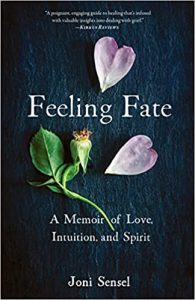Writing Letters to Lost Loved Ones
Writing Letters to Lost Loved Ones
 As a child, I was fascinated by the “dead letter office,” picturing misaddressed mail piling up in a room. Thinking someone should read all that forsaken mail—surely unopened letters were lonely—I wondered if the post office took volunteers.
As a child, I was fascinated by the “dead letter office,” picturing misaddressed mail piling up in a room. Thinking someone should read all that forsaken mail—surely unopened letters were lonely—I wondered if the post office took volunteers.
My romantic notions about “dead letters” took a turn in my 30s, when I wrote a letter to my dead little sister. She died when we were both toddlers, and in dealing with guilt I’d carried for decades, I wrote to her to apologize: Dear Jo Anna. Though I considered posting it with a Heaven address, I didn’t; writing it was enough. In addition to helping me process unexpressed grief, that letter surfaced memories I later used in a novel.
That’s why, when the love of my life died without warning a few years ago, fewer than three days passed before I started writing to him. It felt natural. After all, I’d met him during an island vacation just a few years before, and we carried on a long-distance relationship for five months until we could work out the logistics to share a single home. Texting kept us connected by day, but we poured out our hearts in long emails, too, until the next time we could be in the same zip code. For those like me who identify as writers, the written word carries more weight than whispered sweet nothings over the phone. Plus, ink on paper—even if both are electronic—are less ephemeral. You can save them, savor them, reread them again. So even once we shared an address, we occasionally sent each other love letters, often in email form.
In the days after his death, I retrieved the habit, speaking to him through my pen in a journal he’d given me as a guest. It helped me feel him near me, just beyond the veil.
Over time this lengthy and unposted letter helped me work through my trauma and grief. Again, I eventually turned it into a book about the eerie experiences I’d had with him, which made me feel both our love and his death were predestined. The first half of that book, Feeling Fate: A Memoir of Love, Intuition, and Spirit (April 2022), remains in the form of a letter to him.
Letter writing like this is familiar in therapy circles. It’s a good technique for expressing and releasing difficult emotions, which may flow better in ink than in words on the tongue. But it’s prescribed mostly to help vent resentment or anger, with advice to shred or burn such letters after they’re written.
There are many more reasons to write to lost loved ones, though—from expressing sentiments you wish you’d said to sharing the latest events in your life. There’s also much more to gain. After writing other letters to (and from) Tony in a well-known grief workshop, I’ve begun teaching others to use the technique. Here are 10 tips for getting the most from this tool for anyone struggling with the loss of someone close.
1 Make it a loving ritual. Set aside time when you won’t be interrupted, bolster yourself with a soothing drink or lap blanket, and prepare for tears. Take your time, and don’t stop too soon. The most heartfelt or difficult sentiments may require patience before they’ll bubble up.
2 Trying writing longhand first. If you hate writing manually, your keyboard will work, but a pen slows you down to the pace of your heart. That’s what most needs to speak, not the racing thoughts that drive flying fingers.
3 Express your love. One of the terrors of loss is the secret fear of forgetting—what the beloved looked or sounded like, or how the relationship felt—even if that relationship was with a child unable to be born. Writing it helps reinforce your truth for you.
4 Express your grief. “Wish you were here” is only a start. Listing all the ways your life feels or will be different can help you come to terms with the magnitude of the loss. Plus this is one place you can pour it all out without possibly alienating friends and family. Others’ tolerance for the pain of grief is usually limited, but all of it, every bit, can go in your letter (or a series of them). Paper is cheap. By the way, it’s also okay to express anger. Anyone on the far side of death can take it.
5 Take the chance to speak the unsaid. This includes endearments—or grievances—you should have spoken aloud or secrets you wish you’d shared. This was my main impulse for starting what became my memoir. I wanted Tony to know the one small secret I’d kept from him: On our second weekend together, I’d had a premonition I would lose him early. As crushed as I was when this foresight came true, sharing it with him, even belatedly, cleansed what felt like a flaw in our intimacy and reminded me that love transcends normal reality, including death.
6 Ask the questions you can’t. One of my regrets after Tony was gone was that I’d never found out his beliefs, if any, about an afterlife. He’d laughed about fearing ghosts but avoided my efforts to probe further. I can’t possibly know his experience of dying, even though I was there doing everything I could to prevent it, but I would like to know what he might have expected.
7 Send your letter. Read it aloud, directing your voice to a photo or the heavens. Try burning it so the smoke bears your words up to heaven or burying it somewhere special, consecrating it to the Earth. I’d hesitate to send it by email, since someone else might monitor the account, but there’s nothing to stop you from dropping a sealed envelope into a mailbox. Add a stamp and address if you like, perhaps a significant number on Afterlife Avenue. Leave off any return address. On this plane of existence, it’ll go to my old favorite, the dead letter office. But who’s to say your loved one won’t receive it through the more subtle delivery routes of the heart?
8 Alternately, save your letter somewhere special. Tape it to the back of a photo or tuck it into a memento of the recipient, whether that’s the pocket of a hoodie you’re keeping or beneath the cushion of an easy chair you’ve inherited. It may give you comfort to reread it later, refreshing your sense of the lost one and your love.
9 Consider responding. This is a powerful way to connect. If you loved someone well enough to be grieving, you know them well enough to have some idea how they might answer. Write for them. Summon their vocabulary, their sense of humor or compassion, and their take on the world. Then reply to the letter you wrote them; you might be surprised by what rises. If you can, try using your non-dominant hand, which (although messy) can bring out remarkable insights and messages.
10 Repeat as often as you like. Grief therapists agree that recovering from the loss of a loved one typically includes finding ways to continue the relationship, whether with spirit or memory. That’s why many bereaved people speak, aloud or inside, to whomever they lost, as part of healthy coping. Writing regularly to the dead can provide similar comfort.
These days, what used to be known as the dead letter office often is more likely to be called a mail recovery center. This more hopeful name aligns with sending mail to those you’ve lost. With a little help from recovery center postal employees, misaddressed letters can still reach their intended recipient. Similarly, letters written to the dead can help deliver an eventual recovery from the loss.
###
Joni Sensel is a certified grief educator and the author of more than a dozen books, including her forthcoming memoir, Feeling Fate: A Memoir of Love, Intuition, and Spirit (April 2022). Find more techniques for creative living, a writer’s life, and coping with loss at jonisensel.com.
FEELING FATE
 As her sweetheart’s body lies cooling on the living room floor, Joni Sensel—shattered but not surprised—revisits her premonition about this moment. From nearly the start of their fairy tale romance less than four years ago, she knew she would lose Tony, the man she considered to be her soul mate. He was in great health, but fate had other plans—a hard truth that visited Joni in the form of a startling vision during their second weekend together. Though she kept the premonition a secret while Tony was alive, upon his death she’s compelled to share it with his spirit in the form of a letter.
As her sweetheart’s body lies cooling on the living room floor, Joni Sensel—shattered but not surprised—revisits her premonition about this moment. From nearly the start of their fairy tale romance less than four years ago, she knew she would lose Tony, the man she considered to be her soul mate. He was in great health, but fate had other plans—a hard truth that visited Joni in the form of a startling vision during their second weekend together. Though she kept the premonition a secret while Tony was alive, upon his death she’s compelled to share it with his spirit in the form of a letter.
A grief memoir with a paranormal twist, Feeling Fate explores how a dark intuition magnified Sensel’s love and gratitude in the time she and Tony had together before her premonition came true. Faced with evidence of a grand design alongside her grief, she’s torn between faith and skepticism. While she’s nearly undone by the pain of her loss, she eventually discovers that a sassy imagination and the irrational insights of the heart can both defeat despair and transform her grief into meaning.
BUY HERE
Category: Contemporary Women Writers, How To and Tips
























Thanks for sharing, Joni. Such a wonderful idea.
Widow. Almost 13 years now. Thank you for this post.
My blog began because he had a blog before there were blogs. The Wifely Person was his name for me in his blog…no religious connotations…and it was at his suggestion long before he died that I create a page on Blogpost. Since I didn’t talk in his blog, I chose THE WIFELY PERSON SPEAKS as homage to Harpo and his autobiography, HARPO SPEAKS. And it sat there unused for a number of years
I started writing a year after he was gone. 12.5 years later, I’m still publishing on Monday nights. I thought it would be a blog about being a widow, but it quickly morphed into current events…the thing was talked about most.
I could never write _to_ him, but writing the blog is like writing _with_ him. It fulfills a need I didn’t know I had. I am in the habit of reading each post aloud right before I publish, and that is my “letter” to him.
The act of writing has given me more peace than damn near anything else.